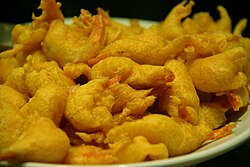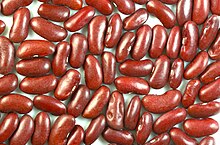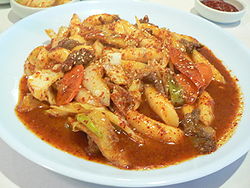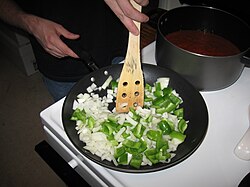Cooking: Difference between revisions
Tkyles1009 (talk | contribs) m Cooking Benefits |
Tkyles1009 (talk | contribs) m none |
||
| Line 184: | Line 184: | ||
==External links== |
==External links== |
||
{{Sister project links|Cooking|wikt=cooking|commons=Cooking|s=Category:Cookbooks}} |
|||
* [[Eating Clean]] |
|||
* [[wikiHow:Cook|wikiHow on How to Cook]] |
* [[wikiHow:Cook|wikiHow on How to Cook]] |
||
* {{dmoz|Home/Cooking}} |
* {{dmoz|Home/Cooking}} |
||
Revision as of 04:14, 18 July 2013

Cooking or cookery is the art or practice of preparing food for consumption with the use of heat. Cooking techniques and ingredients vary widely across the world, reflecting unique environmental, economic, and cultural traditions. Cooks themselves also vary widely in skill and training. Cooking can also occur through chemical reactions without the presence of heat, most notably as in Ceviche, a traditional South American dish where fish is cooked with the acids in lemon or lime juice. Sushi also utilizes a similar chemical reaction between fish and the acidic content of rice glazed with vinegar.

Preparing food with heat or fire is an activity unique to humans, and some scientists believe the advent of cooking played an important role in human evolution.[1] Most anthropologists believe that cooking fires first developed around 250,000 years ago. The development of agriculture, commerce and transportation between civilizations in different regions offered cooks many new ingredients. New inventions and technologies, such as pottery for holding and boiling water, expanded cooking techniques. Some modern cooks apply advanced scientific techniques to food preparation.[2]
History
The examples and perspective in this section deal primarily with the United States and do not represent a worldwide view of the subject. (November 2012) |


There is no clear archaeological evidence when food was first cooked. Most anthropologists believe that cooking fires began only about 250,000 years ago, when hearths started appearing.[3] Phylogenetic analysis by Chris Organ, Charles Nunn, Zarin Machanda, and Richard Wrangham suggests that cooking may have been invented as far back as 1.8 million to 2.3 million years ago.[4] Other researchers believe that cooking was invented as recently as 40,000 or 10,000 years ago. Evidence of fire is inconclusive, as wildfires started by lightning-strikes are still common in East Africa and other wild areas, and it is difficult to determine when fire was first used for cooking, as opposed to just being used for warmth or for keeping predators away.
Wrangham proposed cooking was instrumental in human evolution, as it reduced the time required for foraging and led to an increase in brain size. He estimates the percentage decrease in gut size of early humans directly correlates to the increase in brain size.[5] Most other anthropologists, however, oppose Wrangham,[6] stating that archeological evidence suggests that cooking fires began in earnest only about 250,000 years ago, when ancient hearths, earth ovens, burnt animal bones, and flint appear across Europe and the Middle East. Two million years ago, the only sign of fire is burnt earth with human remains, which most other anthropologists consider to be mere coincidence rather than evidence of intentional fire.[7] The mainstream view among anthropologists is that the increases in human brain size occurred well before the advent of cooking, due to a shift away from the consumption of nuts and berries to the consumption of meat.[8][9]
Food has become a part of material culture, and cuisine is much more than a substance. In the seventeenth and eighteenth centuries, food was a classic marker in Europe. However, in the nineteenth century, cuisine became a defining symbol of national identity. The discovery of the New World represented a major turning point in the history of food because of the movement of foods from and to Europe, such as potatoes, tomatoes, corn, yams, and beans. Food in America consisted of traditions that were adapted from England, but up until the end of this century, the presence of new ingredients along with the contact between diverse ethnic groups influenced experimentation. Industrialization was also a turning point that changed how food affected the nation.
During the period of industrialization, food began to be mass-produced, mass marketed, and standardized. Factories processed, preserved, canned, and packaged a wide variety of foods, and processed cereals quickly became a defining feature of the American breakfast. In the twenties, freezing methods as well as the earliest cafeterias and fast food establishments emerged. This point in time is when processed and nationally distributed foods became a huge part of the nation's diet.
Along with changes in food, there have also been several changes in nutritional guidelines as well. Since 1916, there have been several different nutrition guidelines issued by the United States government, eventually leading up to the food pyramid.[10] In 1916, "Food For Young Children" along with its sequel for adults, "How to Select Foods" was the first USDA guide to give specific dietary guidelines. Updated in the 1920s to these guides gave shopping suggestions for different-sized families along with a Depression Era revision which included four cost levels. In 1943, the USDA created the "Basic Seven" chart to make sure that people got the recommended nutrients. It included the first-ever Recommended Daily Allowances from the National Academy of Sciences. In 1956, the "Essentials of an Adequate Diet" brought recommendations which cut seven down to four groups that school children would learn about for decades. In 1979, a guide called "Food" was published, which addressed the link between too much of certain foods and chronic diseases. This publication also added "fats, oils, and sweets" to the four basic food groups and cautioned moderation. In 1992, the food pyramid was debuted. The USDA introduced this, which represented proportions of foods in a balanced diet. In 2005, the pyramid got a makeover and was renamed MyPyramid. Lastly, in 2011, "MyPlate" came about.
Ingredients
Most ingredients in cooking are derived from living organisms. Vegetables, fruits, grains and nuts as well as herbs and spices come from plants, while meat, eggs, and dairy products come from animals. Mushrooms and the yeast used in baking are kinds of fungi. Cooks also use water and minerals such as salt. Cooks can also use wine or spirits.
Naturally occurring ingredients contain various amounts of molecules called proteins, carbohydrates and fats. They also contain water and minerals. Cooking involves a manipulation of the chemical properties of these molecules.
Carbohydrates

Carbohydrates include the common sugar, sucrose (table sugar), a disaccharide, and such simple sugars as glucose (from the digestion of table sugar) and fructose (from fruit), and starches from sources such as cereal flour, rice, arrowroot, and potato. The interaction of heat and carbohydrate is complex.
Long-chain sugars such as starch tend to break down into simpler sugars when cooked, while simple sugars can form syrups. If sugars are heated so that all water of crystallisation is driven off, then caramelization starts, with the sugar undergoing thermal decomposition with the formation of carbon, and other breakdown products producing caramel. Similarly, the heating of sugars and proteins elicits the Maillard reaction, a basic flavor-enhancing technique.
An emulsion of starch with fat or water can, when gently heated, provide thickening to the dish being cooked. In European cooking, a mixture of butter and flour called a roux is used to thicken liquids to make stews or sauces. In Asian cooking, a similar effect is obtained from a mixture of rice or corn starch and water. These techniques rely on the properties of starches to create simpler mucilaginous saccharides during cooking, which causes the familiar thickening of sauces. This thickening will break down, however, under additional heat.
Fats

Types of fat include vegetable oils, animal products such as butter and lard, as well as fats from grains, including corn and flax oils. Fats can reach temperatures higher than the boiling point of water, and are often used to conduct high heat to other ingredients, such as in frying or sautéing.
Proteins


Edible animal material, including muscle, offal, milk, eggs and egg whites, contains substantial amounts of protein. Almost all vegetable matter (in particular legumes and seeds) also includes proteins, although generally in smaller amounts. Mushrooms have high protein content. Any of these may be sources of essential amino acids. When proteins are heated they become denatured (unfolded) and change texture. In many cases, this causes the structure of the material to become softer or more friable – meat becomes cooked and is more friable and less flexible. In some cases, proteins can form more rigid structures, such as the coagulation of albumen in egg whites. The formation of a relatively rigid but flexible matrix from egg white provides an important component in baking cakes, and also underpins many desserts based on meringue.
Vitamins and minerals
Vitamins are materials required for normal metabolism but which the body cannot manufacture itself and which must therefore come from external sources. Vitamins come from a number of sources including fresh fruit and vegetables (Vitamin C), carrots, liver (Vitamin A), cereal bran, bread, liver e ( B vitamins), fish liver oil (Vitamin D) and fresh green vegetables (Vitamin K). Many minerals are also essential in small quantities including iron, calcium, magnesium and sulphur; and in very small quantities copper, zinc and selenium. The micronutrients, minerals, and vitamins[11] in fruit and vegetables may be destroyed or eluted by cooking. Vitamin C is especially prone to oxidation during cooking and may be completely destroyed by protracted cooking.[12][failed verification]
Water

Cooking often involves water, frequently present in other liquids, which is both added in order to immerse the substances being cooked (typically water, stock or wine), and released from the foods themselves. Liquids are so important to cooking that the name of the cooking method used is often based on how the liquid is combined with the food, as in steaming, simmering, boiling, braising, and blanching. Heating liquid in an open container results in rapidly increased evaporation, which concentrates the remaining flavor and ingredients – this is a critical component of both stewing and sauce making.
Methods
There are very many methods of cooking, most of which have been known since antiquity. These include baking, roasting, frying, grilling, barbecuing, smoking, boiling, steaming and braising. A more recent innovation is microwaving. Various methods use differing levels of heat and moisture and vary in cooking time. The method chosen greatly affects the end result because some foods are more appropriate to some methods than others. Some major hot cooking techniques include:



- Roasting
- Roasting – Barbecuing – Grilling/Broiling – Rotisserie – Searing
- Baking
- Baking – Baking Blind- Flashbaking
- Boiling
- Boiling – Blanching – Braising – Coddling – Double steaming – Infusion – Poaching – Pressure cooking – Simmering – Smothering – Steaming – Steeping – Stewing – Vacuum flask cooking
- Frying
- Fry – Deep frying – Hot salt frying – Hot sand frying – Pan frying – Pressure frying – Sautéing – Stir frying
- Smoking
- Smoking
Cooking and health
Food safety


When heat is used in the preparation of food, it can kill or inactivate potentially harmful organisms, such as bacteria and viruses, as well as various parasites such as tapeworms and Toxoplasma gondii. Food poisoning and other illness from uncooked or poorly-prepared food may be caused by bacteria such as pathogenic strains of Escherichia coli, Salmonella typhimurium and Campylobacter, viruses such as noroviruses, and protozoa such as Entamoeba histolytica. Parasites may be introduced through salad, meat that is uncooked or done rare, and unboiled water.
The sterilizing effect of cooking will depend on temperature, cooking time, and technique used. However, some bacteria such as Clostridium botulinum or Bacillus cereus, can form spores that survive cooking, which then germinate and regrow after the food has cooled. It is therefore recommended that cooked food should not be reheated more than once to avoid repeated growths that allow the bacteria to proliferate to dangerous level.[13]
Cooking prevents many foodborne illnesses that would otherwise occur if the food was eaten raw. Cooking also increases the digestibility of some foods such as grains or lactose because most foods, when raw, are inedible, and some are poisonous. For example kidney beans are toxic when raw or improperly cooked, due to the presence of phytohaemagglutinin which can be inactivated after cooking for at least ten minutes at 100 °C.[14] Slow cooker however may not reach the desired temperature and cases of poisoning from red beans cooked in slow cooker have been reported.
Preparation, handling, and storage of food are other considerations in food safety. According to the USDA, the temperature range from 40 °F to 140 °F (4 to 60 °C), is the "Danger zone" where bacteria is likely to proliferate, food therefore should not be stored in this temperature range. Washing of hands and surfaces, and avoidance of cross-contamination are good practices in food safety.[15] Food prepared on plastic cutting boards may be less likely to harbor bacteria than wooden ones,[16] other research however suggested otherwise.[17] Washing and sanitizing cutting boards is highly recommended, especially after use with raw meat, poultry, or seafood. Hot water and soap followed by a rinse with an diluted antibacterial cleaner, or a trip through a dishwasher with a "sanitize" cycle, are effective methods for reducing the risk of illness due to contaminated cooking implements.[17]
Effects on nutritional content of food


Proponents of Raw foodism argue that cooking food increases the risk of some of the detrimental effects on food or health. They point out that the cooking of vegetables and fruit containing vitamin C both elutes the vitamin into the cooking water and degrades the vitamin through oxidation. Peeling vegetables can also substantially reduce the vitamin C content, especially in the case of potatoes where most vitamin C is in the skin.[18] However, research using an artificial gut has shown that in the specific case of carotenoids a greater proportion is absorbed from cooked vegetables than from raw vegetables.[12]
German research in 2003 showed significant benefits in reducing breast cancer risk when large amounts of raw vegetable matter are included in the diet. The authors attribute some of this effect to heat-labile phytonutrients.[19] Sulforaphane, which may be found in vegetables such as broccoli, has been shown to be protective against prostate cancer, however, much of it is destroyed when the vegetable is boiled.[20]
Cooking and carcinogens
In a human epidemiological analysis by Richard Doll and Richard Peto in 1981, diet was estimated to cause a certain percentage amount of cancers.[21] Some of these cancers may be caused by carcinogens in food generated during cooking process, although it is often difficult to identify the specific components in diet that serve to increase cancer risk. Many food, such as beef steak and broccoli, contain low concentrations of both carcinogens and anticarcinogens.[22]
Several studies published since 1990 indicate that cooking meat at high temperature creates heterocyclic amines (HCAs), which are thought to increase cancer risk in humans. Researchers at the National Cancer Institute found that human subjects who ate beef rare or medium-rare had less than one third the risk of stomach cancer than those who ate beef medium-well or well-done.[23] While eating meat raw may be the only way to avoid HCAs fully, the National Cancer Institute states that cooking meat below 212 °F (100 °C) creates "negligible amounts" of HCAs. Also, microwaving meat before cooking may reduce HCAs by 90%.[23] Nitrosamines, present in processed and cooked foods, have also been noted as being carcinogenic, being linked to colon cancer.
Research has shown that grilling, barbecuing and smoking meat and fish increases levels of carcinogenic Polycyclic aromatic hydrocarbons (PAH). In Europe, grilled meat and smoked fish generally only contribute a small proportion of dietary PAH intake since they are a minor component of diet – most intake comes from cereals, oils and fats.[24] However, in the US, grilled/barbecued meat is the second highest contributor of the mean daily intake of benzo[a]pyrene at 21% after ‘bread, cereal and grain’ at 29%.[24]
Baking, grilling or broiling food, especially starchy foods, until a toasted crust is formed generates significant concentrations of acrylamide, a possible carcinogen.[25]
Other health issues
Cooking dairy products may reduce a protective effect against colon cancer. Researchers at the University of Toronto suggest that ingesting uncooked or unpasteurized dairy products (see also Raw milk) may reduce the risk of colorectal cancer.[26] Mice and rats fed uncooked sucrose, casein, and beef tallow had one-third to one-fifth the incidence of microadenomas as the mice and rats fed the same ingredients cooked.[27][28] This claim, however, is contentious. According to the Food and Drug Administration of the United States, health benefits claimed by raw milk advocates do not exist. "The small quantities of antibodies in milk are not absorbed in the human intestinal tract," says Barbara Ingham, PhD, associate professor and extension food scientist at the University of Wisconsin-Madison. "There is no scientific evidence that raw milk contains an anti-arthritis factor or that it enhances resistance to other diseases."[29]
Heating sugars with proteins or fats can produce Advanced glycation end products ("glycotoxins").[30] These have been linked to ageing and health conditions such as diabetes and causing obesity.
Deep fried food in restaurants may contain high level of trans fat which is known to increase level of low-density lipoprotein that may increase risk of heart diseases and other conditions. However, many fast food chains have now switched to trans-fat-free alternatives for deep-frying.[31]
Science of cooking
The application of scientific knowledge to cooking and gastronomy has become known as molecular gastronomy. This is a subdiscipline of food science. Important contributions have been made by scientists, chefs and authors such as Herve This (chemist), Nicholas Kurti (physicist), Peter Barham (physicist), Harold McGee (author), Shirley Corriher (biochemist, author), Heston Blumenthal (chef), Ferran Adria (chef), Robert Wolke (chemist, author) and Pierre Gagnaire (chef).
Chemical processes central to cooking include the Maillard reaction – a form of non-enzymatic browning involving an amino acid, a reducing sugar and heat.
Home-cooking vs. factory cooking
Although cooking has traditionally been a process carried out informally in a home or around a communal fire, cooking is also often carried out outside of personal quarters, for example at restaurants, or schools. Bakeries were one of the earliest forms of cooking outside the home, and bakeries in the past often offered the cooking of pots of food provided by their customers as an additional service. In the present day, factory food preparation has become common, with many "ready-to-eat" foods being prepared and cooked in factories and home cooks using a mixture of scratch made, and factory made foods together to make a meal.
"Home-cooking" may be associated with comfort food, and some commercially produced foods are presented through advertising or packaging as having been "home-cooked", regardless of their actual origin.
-
Chicken with lemons on a large wooden cutting board.
-
A restaurant kitchen in Munich, Germany (Haxnbauer restaurant).
-
A kitchen in Beijing, China with an assortment of foods.
There are lots of different kinds of different cultural cooking such as French food,Italian food and many other foods from different types of people and cultures.
See also
- Carry over cooking
- Control of fire by early humans
- Cooker
- Cooking weights and measures
- Cuisine
- Culinary arts
- Culinary profession
- Cooking school
- Dishwashing
- Food and cooking hygiene
- Food industry
- Food preservation
- Food writing
- Foodpairing
- Gourmet Library and museum
- High altitude cooking
- International food terms
- List of food preparation utensils
- List of recipes
- Nutrition
- Recipe
- Scented water
- Spices
- Staple (cooking)
References
United States Dept. of Agriculture. (Oct. 13, 2011). Safe Food Handling, Danger Zone. Retrieved from:http://www.fsis.usda.gov/factsheets/Danger_Zone/index.asp on 3/13/13.
- ^ Christine Dell'Amore in Chicago (13 February 2009). "Cooking Gave Humans Edge Over Apes?". National Geographic News.
- ^ W. Wayt Gibbs and Nathan Myhrvold. "A New Spin on Cooking".
- ^ http://cogweb.ucla.edu/Abstracts/Pennisi_99.html
- ^ Organ, Chris (22 August 2011). "Phylogenetic rate shifts in feeding time during the evolution of Homo". PNAS. Retrieved 17 April 2012.
- ^ http://news.harvard.edu/gazette/story/2011/11/why-cooking-counts/
- ^ "Pennisi: Did Cooked Tubers Spur the Evolution of Big Brains?". Cogweb.ucla.edu. Retrieved 31 January 2012.
- ^ Gorman, RM (2008). "Cooking up bigger brains". Scientific American. 298 (1): 102, 104–5. doi:10.1038/scientificamerican0108-102.
- ^ "06.14.99 - Meat-eating was essential for human evolution, says UC Berkeley anthropologist specializing in diet". Berkeley.edu. 14 June 1999. Retrieved 31 January 2012.
- ^ "Meat in the human diet: an anthropological perspective. - Free Online Library". Thefreelibrary.com. 1 September 2007. Retrieved 31 January 2012.
- ^ "The history of the food pyramid". Washington Post. 31 January 2011. Retrieved 18 April 2013.
- ^ Loss of nutrients when vegetables are cooked
- ^ a b "Cooking vegetables 'improves benefits'". BBC News. 2 June 1999. Retrieved 30 April 2010.
- ^ Safe Food Australia – A Guide to the Food Safety Standards
- ^ Noah ND, Bender AE, Reaidi GB, Gilbert RJ (1980). "NEWS, NOTES, AND EPIDEMIOLOGY". Br Med J. 281 (6234): 236–7. PMC 1713670. PMID 7407532.
{{cite journal}}: Unknown parameter|month=ignored (help)CS1 maint: multiple names: authors list (link) - ^ "Basics for Handling Food Safely". United States Department of Agriculture. Retrieved 1 April 2012.
- ^ "Cutting Boards (Plastic Versus Wood)". Food Safety, Preparation and Storage Tips. Cooperative Extension, College of Agriculture & Life Sciences, the University of Arizona. 1998. Archived from the original on 13 June 2006. Retrieved 21 June 2006.
- ^ a b "Cutting Boards – wood or plastic?". ReluctantGourmet.com. Retrieved 21 June 2006.
- ^ Potatoes, nutrition and diet
- ^ Nutr Cancer. 2003;46(2):131-7
- ^ Attention: This template ({{cite doi}}) is deprecated. To cite the publication identified by doi:10.1021/jf990082e , please use {{cite journal}} (if it was published in a bona fide academic journal, otherwise {{cite report}} with
|doi=10.1021/jf990082einstead. - ^ Attention: This template ({{cite pmid}}) is deprecated. To cite the publication identified by PMID 7017215 , please use {{cite journal}} with
|pmid=7017215instead. - ^ Carcinogens and Anticarcinogens in the Human Diet. National Academy Press. 1996. ISBN 0-309-05391-9.
- ^ a b "Heterocyclic Amines in Cooked Meats". National Cancer Institute.
- ^ a b Scientific Committee on Food (4 December 2002). "Polycyclic Aromatic Hydrocarbons – Occurrence in foods, dietary exposure and health effects" (PDF). European Commission. Retrieved 21 August 2010.
- ^ Tareke E, Rydberg P.; et al. (2002). "Analysis of acrylamide, a carcinogen formed in heated foodstuffs". J. Agric. Food. Chem. 50 (17): 4998–5006. doi:10.1021/jf020302f. PMID 12166997.
{{cite journal}}: Explicit use of et al. in:|author=(help) - ^ Corpet DE, Yin Y, Zhang XM; et al. (1995). "Colonic protein fermentation and promotion of colon carcinogenesis by thermolyzed casein". Nutr Cancer. 23 (3): 271–81. doi:10.1080/01635589509514381. PMC 2518970. PMID 7603887.
{{cite journal}}: Explicit use of et al. in:|author=(help)CS1 maint: multiple names: authors list (link) - ^ Corpet DE, Stamp D, Medline A, Minkin S, Archer MC, Bruce WR (1990). "Promotion of colonic microadenoma growth in mice and rats fed cooked sugar or cooked casein and fat". Cancer Res. 50 (21): 6955–8. PMID 2208161.
{{cite journal}}: Unknown parameter|month=ignored (help)CS1 maint: multiple names: authors list (link) - ^ Zhang XM, Stamp D, Minkin S; et al. (1992). "Promotion of aberrant crypt foci and cancer in rat colon by thermolyzed protein". J. Natl. Cancer Inst. 84 (13): 1026–30. doi:10.1093/jnci/84.13.1026. PMID 1608054.
{{cite journal}}: Explicit use of et al. in:|author=(help); Unknown parameter|month=ignored (help)CS1 maint: multiple names: authors list (link) - ^ "Got Milk?" by Linda Bren. FDA Consumer. Sept–Oct 2004.
- ^ Koschinsky T, He CJ, Mitsuhashi T, Bucala R, Liu C, Buenting C, Heitmann K, Vlassara H (1997). "Orally absorbed reactive glycation products (glycotoxins): An environmental risk factor in diabetic nephropathy". Proc. Natl. Acad. Sci. U.S.A. 94 (12): 6474–9. doi:10.1073/pnas.94.12.6474. PMC 21074. PMID 9177242.
{{cite journal}}: CS1 maint: multiple names: authors list (link) - ^ "McDonald's finally picks trans-fat-free oil". MSNBC. 30 January 2007. Retrieved 13 September 2007.
External links
/



